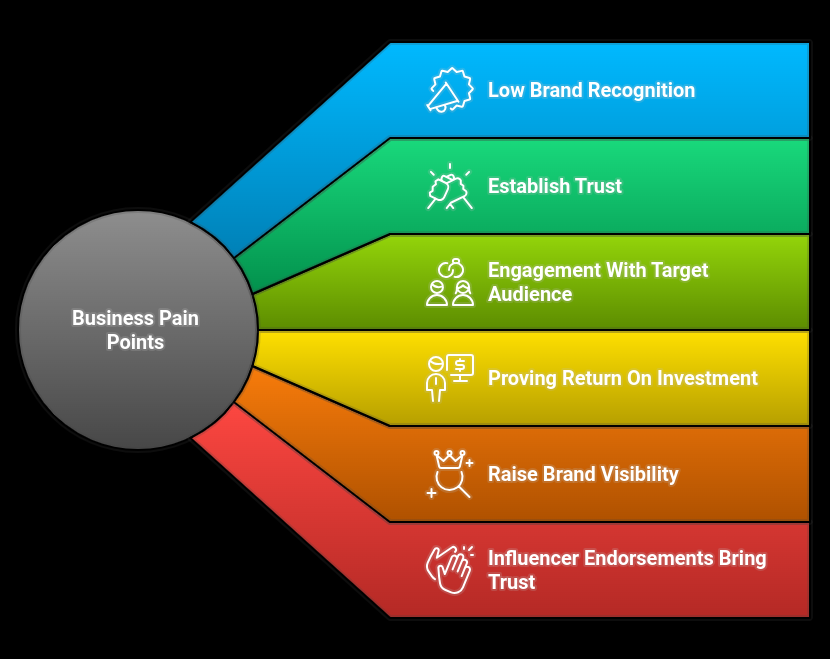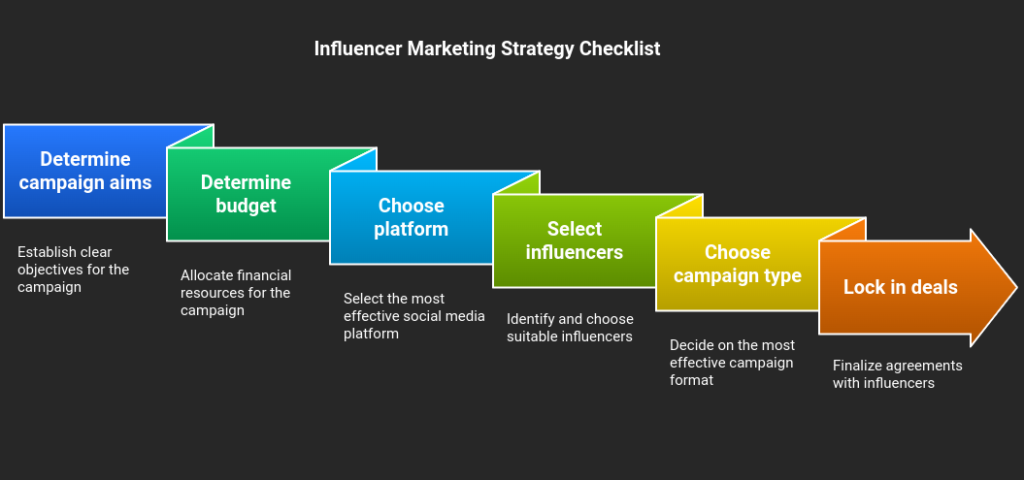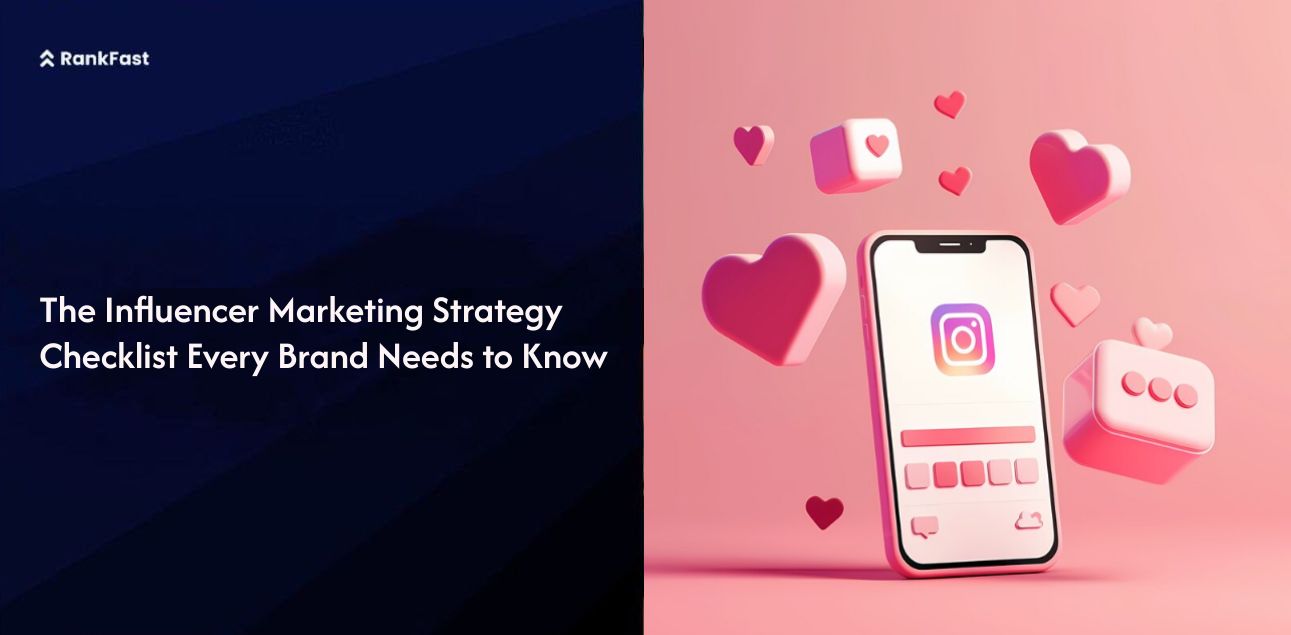Let’s talk about digital marketing, where every component is important. One element that can help create a successful marketing strategy is influencer marketing.Businesses earn an average of $5.20in media value for every $1 spent on influencer marketing.
While trying to get influencer marketing to work for your brand can feel like throwing spaghetti at the wall and hoping it sticks, we have an influencer marketing strategy checklist for you that will force you to stop throwing noodles and start putting together influencer campaigns that actually work and bring you results, not just likes. You will also learn how to select the right influencers for marketing in three steps.
What is Influencer Marketing?
Influencer marketing involves collaborating with individuals (or businesses) who have a large following and influence among a large number of people in certain sectors. These individuals promote businesses, goods, and services via social media, blogs, and email lists in return for items and monetary compensation.
Influencers often provide original content and leverage creatives offered by their partners to persuade their followers to buy the advertised items. As a company, you can effectively use influencers’ reach and influence to promote brand recognition, sales, and consumer engagement.
Note these points:
- An influencer does not have to be a celebrity.
- To force sales, brand authority, and trust, an influencer must have an impact on a certain demographic (social media users).
- An influencer may have a lesser following.
- Although influencing a huge number of individuals can boost your business’s visibility, influencers must have a devoted following who look to them for guidance and brand endorsements.
What Are the Advantages of Influencer Marketing Strategy?
The major advantage of partnering with influencers to promote your items is their connection to their audience. People are more inclined to trust influencers because people relate to them more: they are friends who promote items based on their own experiences rather than a firm advertising its products.
To summarize, working with influencers can lead to the following:
Pain Points Businesses Facing

1. Low Brand Recognition: In an oversaturated market, new or smaller businesses often struggle to stand out.
Example: A small organic skincare brand might produce high-quality products but remain obscure to customers, making it hard for it to attract business.
2. Establish Trust: Consumers tend to mistrust brand messages and prefer authentic recommendations instead.
Example: As a tech startup without established credibility, convincing consumers to invest in its gadget can be challenging.
3. Engagement With Target Audience: Crafting content that resonates with a specific demographic can be challenging.
Example: A local restaurant may struggle to reach younger audiences on social media, leading to minimal interactions and engagement on their page.
4. Proving Return On Investment: Businesses may find it challenging to assess the return on investment (ROI) from their marketing initiatives.
Example: A fitness studio may invest in social media ads but experience limited enrollment, leading to doubts about marketing effectiveness.
5. Raise Brand Visibility: Influencers can quickly expand brand visibility among their established audiences.
Example:Glossierused beauty influencers to rapidly expand its visibility and visibility among its target market on Instagram, effectively expanding both sales and revenue growth.
6. Influencer Endorsements Bring Trust: Influencer endorsements lend authenticity and trustworthiness to brands.
Example:Nike’s partnershipswith athletes like Serena Williams enhance their reputation and position the brand with success.
7. Boost Higher Returns: Influencer marketing often offers higher returns than traditional forms of advertising.
Example:Daniel Wellingtonused influencers to showcase its watches, leading to a 20% sales boost and strong ROI.
Types of Influencer Partnerships
Here are some influencer marketing strategies for influencer marketing collaborations:
Unboxing Videos
These advertisements are often launched on video-based social media sites such as YouTube, TikTok, Instagram Stories, and Feeds.
In these campaigns, social media influencers will promote your items by posting unboxing videos that show their followers what they got and their early responses.
Review Videos
Social influencers can also provide video reviews of your items, focusing on the qualities and advantages that set them apart. Review platforms such as TikTok, Facebook, and niche blogs offer businesses an effective way to enhance brand authenticity and strengthen relationships with prospective customers.
By sharing real experiences and testimonials that resonate with their target market, businesses can create relatable narratives that increase consumer trust and loyalty – leading to higher consumer retention levels overall.
Email Campaign
Email campaigns are an efficient way of engaging prospective consumers by sending tailored, targeted messages directly into their inboxes. The process starts by gathering email addresses through sign-ups and promotions, followed by segmenting audiences for targeted messaging. Composing compelling content – eye-catching subject lines and valuable offers are essential in engaging prospective consumers and driving sales and brand loyalty.
Influencers can add depth to this campaign by featuring your products or brand within their newsletters with exclusive deals or testimonials for loyal followers of influencers introducing your products directly. Analyzing performance metrics such as open and click-through rates helps optimize future campaigns, ultimately leading to sales growth and brand loyalty!
Linking Brands in Social Media Posts
Email campaigns involve sending targeted emails with the intention of meeting certain marketing goals. First, establish your objectives, such as increasing brand recognition or product promotion. Next, build your mailing list using signup forms and ensure subscribers agree to be contacted in this way. Segment your audience for tailored messaging, then develop engaging content featuring personalized greetings, eye-catching subject lines, and clear calls to action. Experiment with when to send emails for maximum engagement.
Utilizing an email marketing platform will help your campaign run efficiently while tracking key metrics such as open and click-through rates, followed by an analysis of results to optimize future campaigns and ensure lasting relationships. Follow-up emails ensure ongoing engagement with your audience.
Avoid These Mistakes in Your Influencer Marketing Strategy
While dealing with influencers is beneficial, there are a few pitfalls you should avoid in social media influencer marketing strategy:
Uncertain KPIs
Before partnering, make sure you have a common understanding of your campaign’s aims. This will help prevent misunderstandings regarding expectations and guarantee the best outcomes.
Prioritizing the incorrect metrics
Vanity metrics can be challenging for both influencers and advertisers. When negotiating metrics with an influencer, prioritize relevant data and targets, such as engagement rate or click-through rate, overreach, follower count, and likes.
Not investigating the influencer
Before working with an influencer, do extensive research on their content, followers, and engagement history. You want to ensure that the influencer you hire aligns with your brand’s beliefs and aims.
Sending incorrect briefings
Your brief should be extremely clear and contain specifics about the influencer’s needs, such as deadlines, brand rules, how you intend to frame your campaign, and so on.
Restricting artistic freedom
Restricting an influencer’s creative freedom can deprive your campaigns of the value they provide to your brand. Collaborate with influencers and let them interpret your message in their distinct way; after all, you want them to promote your goods in an organic, natural manner, right?
Wrong expectations
You can anticipate miracles. Yes, working with influencers is really useful and will enhance brand recognition and revenue – but it is not a quick remedy for all of your challenges. And it’s not like you can convert every influencer photo into a TikTok commercial. Set clear, reasonable expectations for your influencer marketing efforts, and track results closely.
Influencer Marketing Strategy Checklist
Now that you understand why influencer marketing is important in your marketing plan let’s discuss social media influencer marketing strategy:

1. Determine your campaign’s aims
The first step is to identify the objectives of each campaign. Sales will almost always be the primary aim, but each campaign is unique and must be set up properly. For example, if you are releasing a new product or line, you must establish a partnership for pre-orders and promote the message and value that this new line offers. A macro-influencer might be an excellent option here.
If you want to generate a lot of material, you should hunt for smaller influencers who are prepared to offer more content for less money. If you want to increase brand exposure and reach, it’s ideal to work with an influencer with a bigger following.
2. Determine your budget
Each influencer campaign requires a budget, just like any other marketing plan. A budget will contain a monetary value, such as a fee paid directly to influencers or the cost of things given.
Budgets may be allocated by campaign, month, or project. Maintaining a realistic view of the budget and projected outcomes is critical. This will affect the quality of content producers, the material you will get, and the quantity of content pieces created.
3. Choose your platform
The majority of influencers are well-known on a single platform, where their engagement and effectiveness are substantially greater. When searching for influencers, consider their prominent platforms (as well as where your target audience hangs out).
4. Selecting the right influencers
Find the ideal influencers for your business and target demographic. You must use influencer marketing tools to select influencers based on their topic, keywords, hashtags, follower count, and other brand-relevant characteristics. Otherwise, your campaign will not succeed.
For example, if you sell jewelry online and want to find strong influencers to market your products, you should seek a content producer with expertise in writing content for eCommerce firms in that area.
In the next section, we will discuss in detail how to select the right influencers for marketing.
Note: Only some of the influencers you approach will accept your proposal, and not everyone who does will be a good match. That’s okay. The trick is to do extensive study and determine which kind of influencer would appeal to your target audience.
5. Choose the appropriate kind of campaign
Once you’ve identified influencers and established a budget, it’s important to decide which style of campaign would best serve your goals. For example, if you want to increase brand exposure and reach, you may use sponsored content.
Product reviews and giveaways, on the other hand, will demand a greater commitment from influencers and, as a result, a larger expense.
6. Locking in deals
Once both parties agree, you should create a written agreement outlining their expectations, such as:
- Products Provided: A list of the products offered in exchange for endorsement.
- Monetary Compensation: The payment amount offered to the ambassador.
- Affiliate Percentage: The percentage earned on sales through referrals.
- Unique Link/Code: The ambassador’s dedicated tracking link or discount code.
- Terms for Brand Ambassadors: Guidelines and responsibilities expected from the ambassador.
- Product Shipment Timeline: When the products will be sent to the ambassador.
- Content Creation Timeline: The deadline for creating the agreed-upon content.
- Content Posting Timeline: The schedule for posting the content on the ambassador’s platforms.
- Additional Details: Any other specific terms related to the transaction.
Having all these points documented ensures clarity and helps prevent misunderstandings.
7. Controlling the story
One key component of effective influencer marketing is maintaining control over how your brand is displayed online. Influencers and content producers will consider your best interests when finalizing deals, but only if they understand what you need them to accomplish.
Start with a PR document or influencer brief
The first step to a successful influencer campaign is creating a clear PR document or influencer brief. This document should explain exactly what you need from the influencers and include the following:
- Talking Points: Key messages, types of content you’re looking for, and a mood board for inspiration.
- Social Handles: All relevant social media accounts and tags to ensure consistent branding.
This allows influencers to maintain their unique voice while staying aligned with your brand’s goals and guidelines.
Tracking and measuring success
Like any other marketing strategy, influencer relationships should be tracked and measured. Focus on the following metrics to gauge effectiveness:
- Direct Sales: How much revenue is directly attributable to the influencer campaign?
- Clicks and Impressions: The traffic and visibility generated through their content.
Evaluating influencer performance
Assess each influencer’s overall performance to decide on future collaborations. Key factors to consider:
- Communication: Are they responsive and easy to work with?
- Campaign Alignment: Do they understand your objectives and deliver on directives?
- Content Quality: Does their content resonate with your brand and audience?
- Turnaround Time: Are they delivering content promptly?
- Audience Engagement: Is their content generating likes, comments, shares, or other meaningful interactions?
By keeping these points in mind, you can build lasting, productive relationships with influencers who align with your brand and deliver results.
How to Select the Right Influencers for Marketing
Now that you’ve learned how to execute an influencer campaign let’s speak about how to select the right influencers for marketing in three steps:
Pre-selection
To make your influencer marketing campaigns effective, start with a list of influencers that are a great match for your company.
You’ll want to start by curating influencers based on their specialty, keywords, hashtags, follower count, and other brand-relevant characteristics.
Once you’ve pre-selected your influencers, it’s time to contact them and start a discussion. Use tools to pre-select your influencer list, but reach out to them personally to start the discussion and ask if they are open to collaborating.
Ask whether they’re open to partnership, and if so, explain what you’re giving and what you’d want in return.
Vetting and selection
Keep in mind that not every influencer you approach will be interested in partnering, and not everyone who does will be a good match for your company.
Choosing the correct influencers is important to your campaign’s success. That is why, while creating your list of influencers, it is critical to analyze their audience demographics, hobbies, and behavior to ensure that they are consistent with your target audience and brand values.
Additionally, consider the influencer’s engagement metrics, such as likes, comments, shares, and click-through rates, to evaluate how active and engaged their followers are.
Check influencer content
Checking the influencer’s prior collaborations and sponsored material may also help you determine the success of their previous relationships and whether they’re a suitable match for your business.
The quality of the influencer’s material, including aesthetics, tone, and message, is also an important consideration. To maintain consistency and connect with your target audience, make sure the influencer’s material matches your brand’s image and message.
Finally, during the campaign, it is critical to create clear communication and expectations with the chosen influencers to ensure that everyone is on the same page and that the partnership goes well.
Locking in deals
Once you’ve found the ideal influencers, chatted with them, determined a match, and received a “yes” on the campaign’s launch, it’s time to create your influencer marketing agreement.
An influencer marketing agreement is a contract that establishes the terms and conditions of your brand’s engagement with the influencer.
The agreement should cover the scope of work, remuneration, deliverables, and other relevant information about the influencer marketing campaign.
An influencer marketing agreement tries to set clear expectations and obligations for both parties while also ensuring that the cooperation operates well.
Bottom Line
This checklist can help you learn how to select the right influencers for marketing, set clear communication and expectations, and create interesting content that connects with your target audience.
Creating an influencer marketing campaign withRankfast, from picking the appropriate influencers to writing the proper agreement and content, is critical for outperforming your competition.
So throw on your apron, grab your content, and start creating an influencer marketing campaign that will thrill your audience and leave a lasting impact!
FAQs
1: What is influencer marketing, and why is it so vital for brands?
Influencer marketing occurs when businesses collaborate with social media stars to promote goods or services. It’s significant because it uses influencers’ reputations to boost brand exposure, engagement, and conversions more effectively than conventional advertising.
2: How should I choose the proper influencers for my brand?
Consider relevancy to your specialty, engagement rates, authenticity, audience demographics, previous partnerships, and platform fit. Look beyond follower quantity to uncover influencers whose beliefs are consistent with your brand and who have an engaged following that matches your target demographic.
3: How much should I spend on influencer marketing?
Budgets vary greatly depending on campaign objectives and influencer levels. Include influencer payments, content development charges, management tools, and marketing. Many firms spend 10-20% of their digital marketing budget on influencer marketing. Start small, test it, and then grow depending on the outcomes.
4: How can I assess the performance of my influencer marketing campaigns?
Track metrics relevant to your objectives, such as reach, engagement rate, click-through rate, conversions, ROI, and brand perception. Use distinct discount codes or landing pages to monitor influencers specifically. Social media analytics tools like Google Analytics can collect data and compare it to pre-campaign baselines.

Leave a Reply